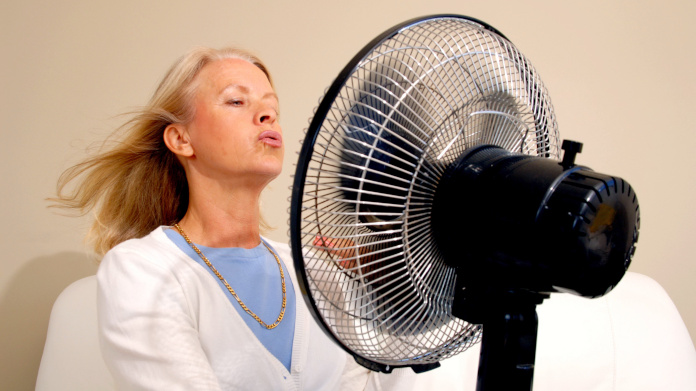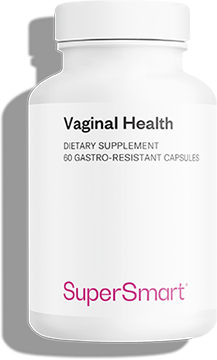How can you increase your progesterone levels naturally?
During the menopause, there’s a fall in progesterone, resulting in a variety of unpleasant symptoms. Here are some natural ways in which you can re-elevate it.

Recap: what is the relationship between progesterone and the menopause?
Initiated at puberty, the ovarian cycle is governed by two key hormones: estrogen and progesterone.
During the first half of the cycle, it is estrogen which takes center stage: produced by maturing follicles in the ovaries, estrogen is responsible for thickening the lining of the womb (endometrium) in preparation for a potential pregnancy.
Halfway through, just after ovulation, things change: the freshly-ruptured follicle gives way to the corpus luteum, which stimulates production of progesterone. This steroid hormone maintains the thickened uterine lining and makes the environment more conducive to implantation.
If fertilisation takes place, estrogen and progesterone continue to be secreted in order to support the pregnancy. If there is no fertilisation, the corpus luteum withers and dies and there is a fall in levels of first progesterone, and then estrogen. This results in a shedding of the uterine lining – in other words, a period, and so the next cycle begins.
Cycles follow one another in this way as long as there is a sufficient reserve of follicles. Between the ages of 45 and 55, however, these finite reserves become exhausted. Levels of estrogen and progesterone gradually decline, and there is a definitive end to the menstrual cycle: after 12 months without a period, a woman is said to be in the menopause.
This major transition can unfold without any problems. However, the significant change in hormone levels proves disruptive to daily life for many women who experience what are termed ‘climacteric’ symptoms: hot flashes, night sweats, headaches, sleep problems, irritability… For some, these problems begin many years before the menopause, and mark their entry into the peri-menopause.
Though often short-lived, this considerable discomfort can also last for some time after periods have stopped. The good news is there are various ways of restoring adequate progesterone levels to successfully transition through this dreaded stage of a woman’s life.
Prioritise ‘progesterone-friendly’ foods
A good place to start is diet. During the menopause, it’s wise to prioritise certain foods for their significant progesterone content. Top of this list are egg yolks, dairy products (especially from cow’s milk) and poultry (1-2).
Conversely, you should limit your intake of foods that mimic the effects of estrogen in the body in order to maintain progesterone status. Among dietary sources of phytoestrogens which should be restricted are, in particular, soya, linseed, fennel and oats. (3). Similarly, if you’re a fan of herbal teas, you should avoid certain types such as sage and hop.
As for the rest of your diet, stick to the usual nutritional guidelines : fresh fruits and vegetables to stock up on vitamins and minerals, and healthy fats (mono and polyunsaturated rather than saturated).
Lose weight to increase your progesterone levels
If you feel bloated, it could be because the fall in hormone levels affects the body’s metabolism of lipids ... and its propensity to store fats. It’s therefore not uncommon for women to gain weight when they reach the menopause (4). Interestingly, some animal studies suggest that shedding a few excess pounds could significantly raise levels of progesterone in the blood (5).
But if you’re tempted to start a crash diet, think again. Losing weight too quickly puts you at risk of creating a second hormonal storm. Instead, take a gradual approach, modifying your lifestyle slowly but surely. The key is to combine regular exercise with a slight reduction in your daily calorie intake.
Opt for a direct intake of progesterone
Some menopausal or peri-menopausal women also choose to supplement with progesterone
If you’d rather avoid synthetic formulations, choose a natural, plant-based progesterone such as that obtained from yams, which is bio-identical in structure to the female hormones (7). This is available either as a classic cream (such as Natural Progesterone Cream, with a liposomal formulation for optimal penetration) or as a handy spray (such as Natural Progesterone Spray, enriched with vitamin E for maximum uptake).
Manage your stress levels to lower conversion into cortisol
Loss of femininity, feelings of emptiness, existential crisis: the menopause can place huge strain on your psychogical and emotional well-being. Unfortunately, cortisol (the famous ‘stress hormone’) and progesterone share the same precursor: pregnenolone.
As a result, in the case of prolonged exposure to stress, the body prioritises cortisol production to ensure your ‘survival’, pushing progesterone to the back burner (6).
So to raise your progesterone, try to lower your stress levels as much as possible through gentle approaches such as yoga, meditation and sophrology.
And once again, nature is there to help! More commonly-known as Indian ginseng, ashwagandha (Withania somnifera) is a classic Ayurvedic adaptogen plant which promotes optimal relaxation, mental well-being and stress reduction (7-8). It can be found in certain cutting-edge supplements (such as Super Ashwagandha, standardized to 5% withanolides for optimal efficacy).
References
- Shrem G, Gilman A, Buckett W, Balayla J, Son WY, Lefebvre J, Jin SG, Dahan MH. Amount of Progesterone Consumed Based on Varying Fat Concentrations, Dietary Recommendations, and Estimated Safe Levels in Commercial Cow Origin Liquid Dairy Products. J Med Food. 2019 Sep;22(9):971-974. doi: 10.1089/jmf.2019.0018. Epub 2019 Jun 14. PMID: 31199703.
- Mumford SL, Chavarro JE, Zhang C, Perkins NJ, Sjaarda LA, Pollack AZ, Schliep KC, Michels KA, Zarek SM, Plowden TC, Radin RG, Messer LC, Frankel RA, Wactawski-Wende J. Dietary fat intake and reproductive hormone concentrations and ovulation in regularly menstruating women. Am J Clin Nutr. 2016 Mar;103(3):868-77. doi: 10.3945/ajcn.115.119321. Epub 2016 Feb 3. PMID: 26843151; PMCID: PMC4763493.
- Davis SR, Castelo-Branco C, Chedraui P, Lumsden MA, Nappi RE, Shah D, Villaseca P; Writing Group of the International Menopause Society for World Menopause Day 2012. Understanding weight gain at menopause. Climacteric. 2012 Oct;15(5):419-29. doi: 10.3109/13697137.2012.707385. PMID: 22978257.
- Rodrigues RO, Trevisanuto C, Cooke RF, Vasconcelos JL. Effects of body weight loss on serum progesterone concentrations of non-lactating dairy cows. Theriogenology. 2011 Jan 1;75(1):131-7. doi: 10.1016/j.theriogenology.2010.07.018. Epub 2010 Sep 27. PMID: 20875677.
- Schliep KC, Mumford SL, Vladutiu CJ, et al. Perceived stress, reproductive hormones, and ovulatory function: a prospective cohort study. Epidemiology. 2015;26(2):177-184. doi:10.1097/EDE.0000000000000238
- Lieberman A, Curtis L. In Defense of Progesterone: A Review of the Literature. Altern Ther Health Med. 2017 Nov;23(6):24-32. PMID: 29055286.
- Salve J, Pate S, Debnath K, Langade D. Adaptogenic and Anxiolytic Effects of Ashwagandha Root Extract in Healthy Adults: A Double-blind, Randomized, Placebo-controlled Clinical Study. Cureus. 2019;11(12):e6466. Published 2019 Dec 25. doi:10.7759/cureus.6466
- Singh N, Bhalla M, de Jager P, Gilca M. An overview on ashwagandha: a Rasayana (rejuvenator) of Ayurveda. Afr J Tradit Complement Altern Med. 2011;8(5 Suppl):208-213. doi:10.4314/ajtcam.v8i5S.9
Keywords
10 Hours
On time shipping
On time shipping
GEORGE Verne
2 Days
Ordering was easy and the product was…
Ordering was easy and the product was delivered with no problems. Appreciated that I was notified when it would arrive. Thanks!
MascarC
7 Days
Great customer service - responsive …
I ordered from them and my item was unavailable for sometime. I was super happy when they reactivated my order and shipped my item which arrived very quickly. Great customer service.
Ruth Rueter
8 Days
Super fast shipping
Super fast shipping
Donald Borling
11 Days
Reputable companysearch and the number of…
The research and the number of selection of products.
NAKHJAVAN Shervin
24 Days
The Anti Aromatase is a great product
The Anti Aromatase is a great product. You just need to have constant inventory. Recently this product has been out of stock.
GEORGE Verne
26 Days
Great help on chat
Great help on chat. Knowledgeable and friendly.
Jason Argos
29 Days
Customer service was fast and friendly.
Customer service helped to stop the transaction process of the subscription. I appreciated that.
Greenie
30 Days
I order here due to the high quality of…
I order here due to the high quality of the products and the quick delivery of items - thank you
Barbara J
31 Days
SuperSmart's Eye Pressure supplements: highly recommended!
I purchase SuperSmart's Eye Pressure supplements regularly for over 5 years, and gotta say they are truly a wonderful product for my Glaucoma. Highly recommended if you have eye pain from your Glaucoma.
D. Martinez
36 Days
Quick service
Quick service
MONELL
36 Days
Speedy service.
Speedy service.
ROSENTHAL Marvin
40 Days
Clear website- Efficient
Clear website. Excellent search engine and fast delivery!
Mohamad Hussein
43 Days
They have great products.
They have great products.
Vickie
43 Days
Great Shipping Time!
You Have A Great Shipping Time! Praise The Lord!
DMHoge





